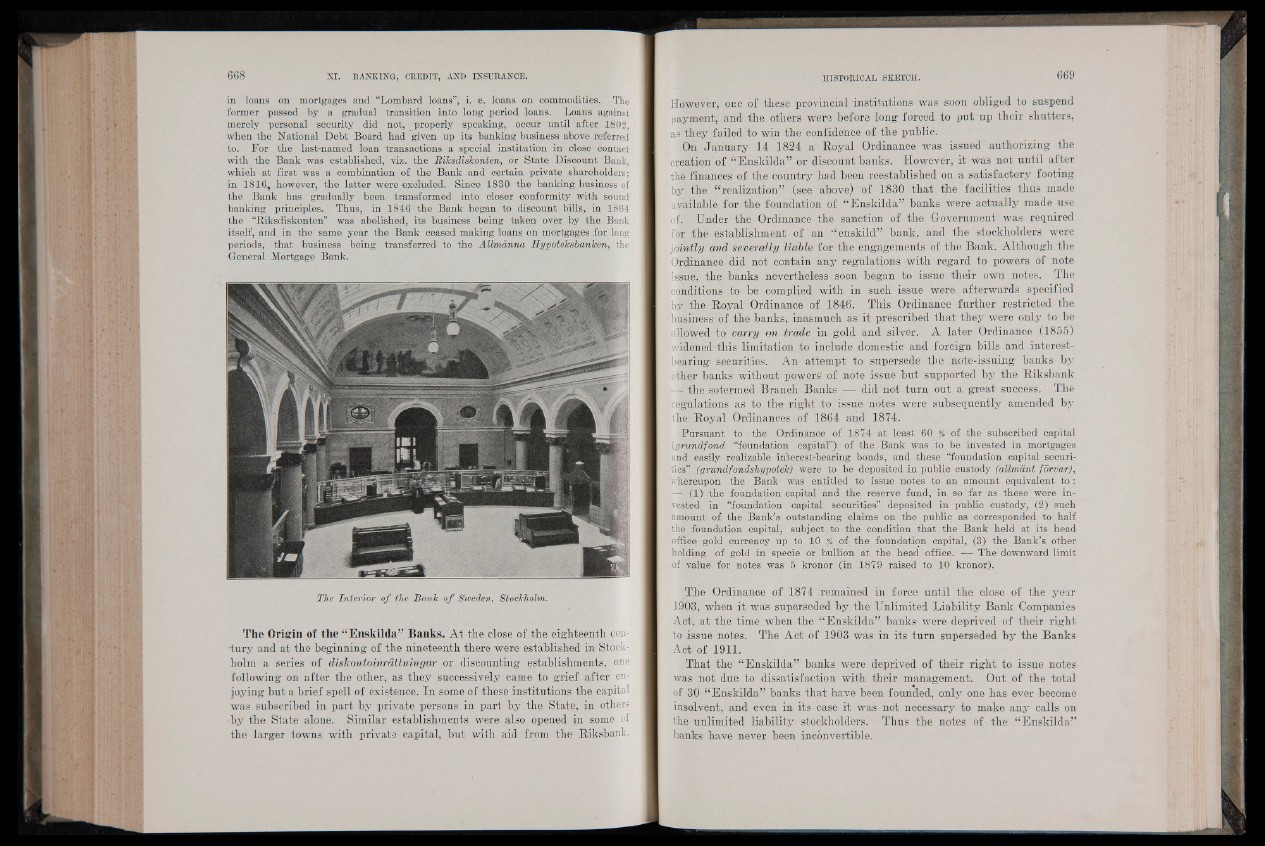
in loans on mortgages and “Lombard loans”, i. e. loans on commodities. The
former passed by a gradual transition into long period loans. Loans against
merely personal security did not, . properly speaking, occur until after 1802,
when the National Debt Board had given up its banking business above referred
to. For the last-named loan transactions a special institution in close contact
with the Bank was established, viz. the Riksdiskonten, or State Discount Bank,
which at first was a combination of the Bank and certain private shareholders;
in 1816, however, the latter were excluded. Since 1830 the banking business of
the Bank has gradually been transformed into closer conformity with sound
banking principles. Thus, in 1846 the Bank began to discount bills, in 1864
the “Riksdiskonten” was abolished, its business being taken over by the Bank
itself, and in the same year the Bank ceased making loans on mortgages for long
periods, that business being transferred to the Allmànna Hypoteksbanken, the
General Mortgage Bank.
The Interior o f the Bank o f Sweden, Stockholm.
The Origin of the “Enskilda” Banks. At the close of the eighteenth century
and at the beginning of the nineteenth there were established in Stockholm
a series of diskontoinrattningar or discounting e s t a b l i s h m e n t s , one
following on after the other, as they successively came to grief after enjoying
hut a brief spell of existence. In some of these institutions the c a p i t a l
was subscribed in part by private persons in part by the State, in others
by the State alone. Similar establishments were also opened in some of
the larger towns with private capital, hut with aid from the R ik s b a n k .
However, one of these provincial institutions was soon obliged to suspend
payment, and the others were before long forced to put up their shutters,
as they failed to win the confidence of the public.
On January 14 1824 a Royal Ordinance was issued authorizing the
creation of “ Enskilda” or discount banks. However, it was not until after
the finances of the country had been reestablished on a satisfactory footing
by the “ realization” (see above) of 1830 that the facilities thus made
available for the foundation of “Enskilda” banks were actually made use
of. Under the Ordinance the sanction of thé Government was required
for the establishment of an “ enskild” hank, and the stockholders were
jointly and severally liable for the engagements of the Bank. Although the
Ordinance did not contain any regulations with regard to powers of note
issue, the banks nevertheless soon began to issue their own notes. The
conditions to be complied with in such issue were afterwards specified
by the Royal Ordinance of 1846. This Ordinance further restricted the
business of the banks, inasmuch as it prescribed that they were only to be
allowed to carry on trade in gold and silver. A later Ordinance (1855)
widened this limitation to include domestic and foreign bills and interest-
hearing securities. An attempt to supersede the note-issuing banks by
other banks without powers'-of note issue but supported by the Riksbank
—- the sotermed Branch Banks did not turn out a great success. The
regulations as to the right to issue notes were subsequently amended by
the Royal Ordinances of 1864 and 1874.
Pursuant to the Ordinance of 1874 at least 60 % of the subscribed capital
(grundfond “foundation capital”) of the Bank was to be invested in mortgages
and easily realizable interest-bearing bonds, and these “foundation capital securi-
ties”_ (grundfondshypotek) were to be deposited in public custody (allmànt f 'àrvar),
whereupon the Bank was entitled to issue notes to an amount equivalent to :
—- (I)" 'the foundation capital and the reserve fund, in bo far as these were invested
in “foundation capital securities” deposited in public custody, (2) such
amount of the Bank’s outstanding claims on the public as corresponded to half
the foundation capital, subject to the- condition that the Bank held at its head
office gold currency up to 10 % of the foundation capital, (3) the Bank’s other
holding of gold in specie or bullion at the head office. — The downward limit
of value for notes was 5 kronor (in 1879 raised to 10 kronor).
The Ordinance of 1874 remained in force until the close of the year
’1903, when it was superseded by the Unlimited Liability Bank Companies
Act, at the time when the “Enskilda” banks were deprived of their right
to issue notes. The Act of 1903 was in its turn superseded by the Banks
Act of 1911.
That the “Enskilda” hanks were deprived of their right to issue notes
was not due to dissatisfaction with their management. Out of the total
of 30 “Enskilda” banks that have been founded, only one has ever become
insolvent, and even in its case it was not necessary to make any calls on
the unlimited liability stockholders. Thus the notes of the “Enskilda”
banks have never been inconvertible.